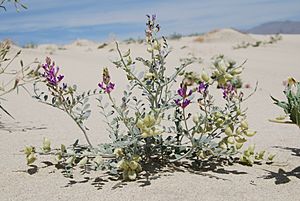Spotted locoweed facts for kids
Quick facts for kids Astragalus lentiginosus |
|
|---|---|
 |
|
| Scientific classification |
Astragalus lentiginosus is a type of plant called a legume. It is also known by its common names: spotted locoweed and freckled milkvetch. This plant grows naturally in western North America. You can find it in many different kinds of places. There are many wild types, or varieties, of this plant. They can look quite different from each other. To figure out which variety a plant is, you usually need to look closely at its flowers and fruits.
Contents
Where It Grows (Distribution)
Astragalus lentiginosus grows across a large area of western North America. This includes the Great Basin, stretching from the Rocky Mountains in the east to the California Coast Ranges in the west. It also grows south into Mexico and north into British Columbia.
Most of its varieties like to grow in specific, often challenging, places. These can be disturbed areas in dry regions. Some varieties are special because they only grow in certain types of soil. For example, they might be found where desert water seeps out. These spots often have a lot of calcium carbonate in the soil.
What It Looks Like (Description)
Astragalus lentiginosus is usually a plant that lives for many years (a perennial). Sometimes, it can live for just one year (an annual). Its leaves can grow up to 15 centimeters (about 6 inches) long. Each leaf has many small leaflets arranged in pairs.
The plant can grow flat along the ground or stand upright. It can be very fuzzy or almost smooth. Its flowers grow in a cluster called an inflorescence. This cluster can hold up to 50 pea-like flowers. These flowers might be purple, whitish, or a mix of both colors.
A key feature that helps identify most varieties is their fruit. It's an inflated, beaked legume pod with a groove along its side. When the pod dries, it becomes thin like paper. It then splits open from the beak to release its seeds. The name lentiginosus comes from the red spots often seen on the pods. These spots look a lot like freckles.
How It's Classified (Taxonomy)
Many of the plants we now call varieties of Astragalus lentiginosus were once thought to be separate species. A botanist named Marcus E. Jones was the first to notice how similar these plants were. He decided to group them as different varieties of one species.
Later, another botanist, Per Axel Rydberg, had different ideas. He didn't believe in using "infrataxa" (groups smaller than a species). So, he changed Jones's varieties back into separate species. He put them into different plant groups called Cystium and Tium. Even though his main idea was different, some of his ways of organizing the plants are still used today.
Other botanists like Rupert C. Barneby, Isely, and Welsh have also studied this plant. Their classifications are a bit different, recognizing between 36 and 42 types. Recent studies looking at the plant's genes seem to show that these varieties are indeed genetically distinct.
Varieties
Currently, about 40 different varieties of Astragalus lentiginosus are recognized. Here are some of them:
- A. l. var. albifolius M.E.Jones 1923.
- A. l. var. ambiguus Barneby 1964.
- A. l. var. antonius Barneby 1945.
- A. l. var. araneosus (E.Sheld.) Barneby 1945.
- A. l. var. australis Barneby 1945.
- A. l. var. borreganus M.E.Jones 1898.
- A. l. var. chartaceus M.E.Jones 1895.
- A. l. var. coachellae Barneby 1964.
- A. l. var. diphysus (A.Gray) M.E.Jones 1895.
- A. l. var. floribundus Gray 1865.
- A. l. var. fremontii (A.Gray 1857) S.Watson 1871.
- A. l. var. higginsii S.L.Welsh 1981.
- A. l. var. idriensis M.E.Jones 1902.
- A. l. var. ineptus (A.Gray) M.E.Jones 1923.
- A. l. var. kennedyi (Rydb.) Barneby 1945.
- A. l. var. kernensis (Jeps.) Barneby 1945.
- A. l. var. latus (M.E.Jones) M.E.Jones 1923.
- A. l. var. lentiginosus Barneby 1964.
- A. l. var. maricopae Barneby 1945.
- A. l. var. micans Barneby 1956.
- A. l. var. mokiacensis (A.Gray) M.E.Jones 1923.
- A. l. var. multiracemosus S.L.Welsh & N.D.Atwood 2007.
- A. l. var. negundo S.L.Welsh & N.D.Atwood 2007.
- A. l. var. nigricalycis M.E.Jones 1895.
- A. l. var. oropedii Barneby 1945.
- A. l. var. palans (M.E.Jones) M.E.Jones 1898.
- A. l. var. piscinensis Barneby 1977.
- A. l. var. pohlii S.L.Welsh & Barneby 1981.
- A. l. var. salinus (Howell) Barneby 1945.
- A. l. var. scorpionis M.E.Jones 1923.
- A. l. var. semotus Jeps. 1936.
- A. l. var. sesquimetralis (Rydb.) Barneby 1945.
- A. l. var. sierrae M.E.Jones 1923.
- A. l. var. stramineus (Rydb.) Barneby 1945.
- A. l. var. trumbullensis S.L.Welsh & N.D.Atwood 1981.
- A. l. var. ursinus (A.Gray) Barneby 1945.
- A. l. var. variabilis Barneby 1945.
- A. l. var. vitreus Barneby 1945.
- A. l. var. wilsonii (Greene) Barneby 1945.
- A. l. var. yuccanus M.E.Jones 1898.
Protecting the Plant (Conservation)
Two rare varieties of Astragalus lentiginosus are found only in California. These are protected by law under the Endangered Species Act. The variety coachellae is considered endangered, meaning it is at high risk of disappearing. The variety piscinensis is considered threatened, meaning it could become endangered in the future.
Growing the Plant (Cultivation)
Astragalus lentiginosus is not currently grown for sale. If you want to grow it from seeds, you need to prepare the seeds first. This process is called scarification. It helps the seed coat break open so the tiny plant inside can absorb water and start to grow.
How People Use It (Uses)
The Zuni people, a Native American tribe, eat the pods of the diphysus variety. They eat them fresh, boiled, or salted. They also dry the pods to store them for use during the winter months.


